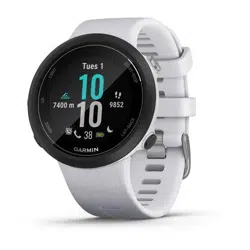Loading ...
Loading ...
Loading ...

HR %Max.: The percentage of maximum heart rate.
HR Zone: The current range of your heart rate (1 to 5). The
default zones are based on your user profile and maximum
heart rate (220 minus your age).
Int. Avg. %HRR: The average percentage of heart rate reserve
(maximum heart rate minus resting heart rate) for the current
swim interval.
Int. Avg. %Max.: The average percentage of maximum heart
rate for the current swim interval.
Int. Avg. HR: The average heart rate for the current swim
interval.
Int. Distance: The distance traveled for the current interval.
Int. Max. %HRR: The maximum percentage of heart rate
reserve (maximum heart rate minus resting heart rate) for the
current swim interval.
Int. Max. %Max.: The maximum percentage of maximum heart
rate for the current swim interval.
Int. Max. HR: The maximum heart rate for the current swim
interval.
Int. Pace: The average pace for the current interval.
Interval Lengths: The number of pool lengths completed during
the current interval.
Intervals: The number of intervals completed in the current
activity.
Interval Strokes Per Length: The average number of strokes
per pool length during the current interval.
Interval Stroke Type: The current stroke type for the interval.
Interval Swolf: The average swolf score for the current interval.
Interval Time: The stopwatch time for the current interval.
L. Lap HR %Max.: The average percentage of maximum heart
rate for the last completed lap.
Lap %HRR: The average percentage of heart rate reserve
(maximum heart rate minus resting heart rate) for the current
lap.
Lap Distance: The distance traveled for the current lap.
Lap Distance Per Stroke: Swimming. The average distance
traveled per stroke during the current lap.
Lap HR: The average heart rate for the current lap.
Lap HR %Max.: The average percentage of maximum heart
rate for the current lap.
Lap Pace: The average pace for the current lap.
Laps: The number of laps completed for the current activity.
Lap Stroke Rate: Swimming. The average number of strokes
per minute (spm) during the current lap.
Lap Strokes: Swimming. The total number of strokes for the
current lap.
Lap Swolf: The swolf score for the current lap.
Lap Time: The stopwatch time for the current lap.
Last Lap %HRR: The average percentage of heart rate reserve
(maximum heart rate minus resting heart rate) for the last
completed lap.
Last Lap Dist.: The distance traveled for the last completed lap.
Last Lap Distance Per Stroke: Swimming. The average
distance traveled per stroke during the last completed lap.
Last Lap HR: The average heart rate for the last completed lap.
Last Lap Pace: The average pace for the last completed lap.
Last Lap Stroke Rate: Swimming. The average number of
strokes per minute (spm) during the last completed lap.
Last Lap Strokes: Swimming. The total number of strokes for
the last completed lap.
Last Lap Swolf: The swolf score for the last completed lap.
Last Lap Time: The stopwatch time for the last completed lap.
Last Len. Pace: The average pace for your last completed pool
length.
Last Length Strokes: The total number of strokes for the last
completed pool length.
Last Length Stroke Type: The stroke type used during the last
completed pool length.
Last Length Swolf: The swolf score for the last completed pool
length.
Lengths: The number of pool lengths completed during the
current activity.
Pace: The current pace.
Repeat On: The timer for the last interval plus the current rest
(pool swimming).
Rest Timer: The timer for the current rest (pool swimming).
Speed: The current rate of travel.
Steps: The number of steps during the current activity.
Stroke Rate: Swimming. The number of strokes per minute
(spm).
Strokes: Swimming. The total number of strokes for the current
activity.
Swim Time: The swimming time for the current activity, not
including rest time.
Time in Zone: The time elapsed in each heart rate or power
zone.
Time of Day: The time of day based on your current location
and time settings (format, time zone, daylight saving time).
Timer: The stopwatch time for the current activity.
ANT+ Heart Rate Monitor
Your device can be used with wireless ANT+ sensors. For more
information about compatibility and purchasing optional sensors,
go to http://buy.garmin.com.
Pairing Your External Heart Rate Monitor
The first time you connect a wireless sensor to your device
using ANT+ technology, you must pair the device and sensor.
After they are paired, the device connects to the sensor
automatically when you start an activity and the sensor is active
and within range.
1
Put on the heart rate monitor.
The heart rate monitor does not send or receive data until
you put it on.
2
Bring the device within 3 m (10 ft.) of the sensor.
NOTE: Stay 10 m (33 ft.) away from other ANT+ sensors
while pairing.
3
From the watch face, hold UP.
4
Select > Sensors & Accessories > Add External HR.
When the sensor is paired with your device, a message
appears. Sensor data appears in the data screen loop or a
custom data field.
Fitness Goals
Knowing your heart rate zones can help you measure and
improve your fitness by understanding and applying these
principles.
• Your heart rate is a good measure of exercise intensity.
• Training in certain heart rate zones can help you improve
cardiovascular capacity and strength.
If you know your maximum heart rate, you can use the table
(Heart Rate Zone Calculations, page 8) to determine the best
heart rate zone for your fitness objectives.
16 Appendix
Loading ...
Loading ...
Loading ...
